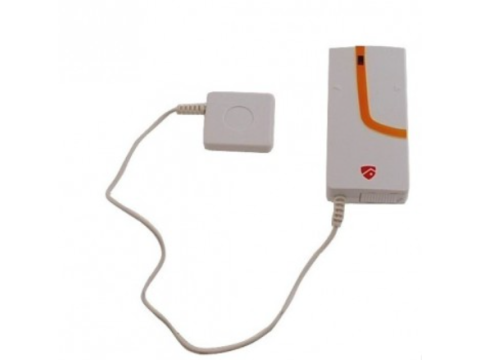Vibration detectors (sometimes called shock sensors) specialize in identifying break-in attempts through destructive means—such as drilling, hammering, or smashing walls and doors. Often placed on walls, safes, grates, or perimeter fences, these sensors “feel” the vibrations from an intruder’s physical force and trigger an alarm before the attacker gains entry. Below, we discuss the main types of vibration sensors, their advantages, and best practices for installation.
Vibration Sensor Basics
Targeted Intrusion Methods
- Breaking or drilling walls, ceilings, or floors
- Sawing or cutting metal surfaces (safes, vaults)
- Hammering or applying strong impact
Design & Processing
- Typically one-piece units: The sensing element (piezo, accelerometer, etc.) and signal processor are in the same enclosure.
- Some systems allow multiple external sensors linked to a single processing module (e.g., “Shorokh 2-10”).
Surface Coverage
- Vibration sensors have a surface detection zone (e.g., a circle with a certain radius).
- The sensor’s documentation specifies the maximum protected area and how it varies by construction material (wood, concrete, metal, etc.).
Types of Vibration Detectors
Single-Unit Sensors
- Commonly used for walls, doors, safes, or windows.
- The unit is mounted directly to the surface it protects.
- Examples: “Shorokh-2,” “Shorokh-1,” etc.
Multi-Sensor Systems
- A single processing unit plus multiple vibration pickups—like the “Shorokh 2-10,” supporting up to ten separate heads.
- Each pickup can protect a distinct section of a larger wall or multiple safes in a vault.
Perimeter “Triboelectric” Cables
- E.g., “Liana,” where a sensitive cable reacts to fence deformation.
- Sometimes grouped under “vibration sensors,” although it more specifically detects cable bending or shaking.
- Ideal for long perimeters (up to 300 meters).
Indoor vs. Outdoor Versions
- Outdoor-rated models have robust housings and are designed for fences or exposed surfaces.
- Indoor models typically handle walls, vault rooms, or safes.
Wired vs. Wireless
- Wired is the norm for vibration sensors, as these devices require stable, interference-free performance.
- Wireless vibration sensors are rare; if needed, you can wire a standard sensor to a compatible wireless transmitter.
When to Use Vibration Detectors
Vibration sensors can detect forced entry earlier than typical door/window contacts or motion detectors—often before the intruder fully breaches the structure. They’re especially relevant for:
- High-Value Storage: Bank vaults, jewelry shops, data centers.
- Thin Walls or “non-capital” partitions (e.g., single-brick walls).
- Steel gates or shutters that might be forcibly pried or cut open.
However, vibration sensors may be overkill for standard applications where break-ins usually target doors or windows rather than walls. Their specialized design and higher cost often limit them to critical or high-risk locations.
Limitations & Considerations
- Cost
- Vibration sensors can be more expensive than basic motion or magnetic sensors.
- False Alarms
- Renovation activities (drilling, hammering in adjacent areas) can trigger unwanted alerts.
- Solutions include lowering sensitivity or temporarily disabling the sensor (risky if not properly managed).
- Material Dependence
- Performance depends on the surface’s ability to transmit vibrations (steel or concrete is better than loosely connected elements).
- Area Coverage
- Typically given in square feet or square meters. Real coverage is a circular zone; you need to account for shape and layout.
Installation & Mounting Tips
Identify High-Risk Barriers
- Vault walls, cashier rooms, or any structure adjacent to unmonitored exteriors.
- Thin, easily breachable walls (e.g., single-layer brick) are prime candidates.
Create a Dedicated “Vibration” Zone
- For large systems, wire vibration sensors into their own loop (zone).
- Monitoring centers may keep a special watch on this zone, as an alarm indicates active tampering.
Placement
- Mount the detector firmly onto the protected surface using the recommended adhesive or hardware.
- Ensure secure contact to transmit vibrations accurately.
- If a sensor covers multiple wall segments, verify those segments are rigidly connected to effectively transfer shock waves.
Outdoor Applications
- Use outdoor-rated devices with weatherproof housings (IP or NEMA-rated).
- Protect cables from tampering—bury them or route them through conduit.
- Evaluate wind and environmental noise to avoid false alarms.
Sensitivity Adjustments
- Many sensors feature sensitivity knobs or DIP switches. Start with the manufacturer’s recommended setting, then fine-tune as needed to avoid nuisance alarms.
Examples of Vibration Sensor Use Cases
- Bank Vault or Safe Room: Early detection of drilling or hammering through reinforced concrete or steel.
- Perimeter Fence: Triboelectric cable (like “Liana”) to detect cutting or climbing attempts.
- Retail High-Value Storage: Jewelry counters or back-room safes that could be forcibly entered.
Conclusion
Vibration detectors fill a crucial niche in security alarm systems, detecting forceful intrusions that bypass conventional door/window sensors or motion detectors. While they excel in high-security or specialized environments (bank vaults, treasury rooms, perimeter fences), they’re less common for everyday scenarios due to higher costs and potential for false alarms caused by nearby construction or heavy impacts.
Key Takeaways:
- Ideal for reinforced walls, safe rooms, fences, or vaults.
- Early detection of drilling, hammering, or cutting attacks.
- Involves careful mounting for stable, direct contact with surfaces.
- Sensitivity must balance early detection vs. false triggers.
For in-depth guidance on selecting and installing vibration detectors—or other specialized sensors—visit safsale.com. Our security experts can recommend solutions tailored to your unique requirements, ensuring robust protection against even the most determined intruder.

